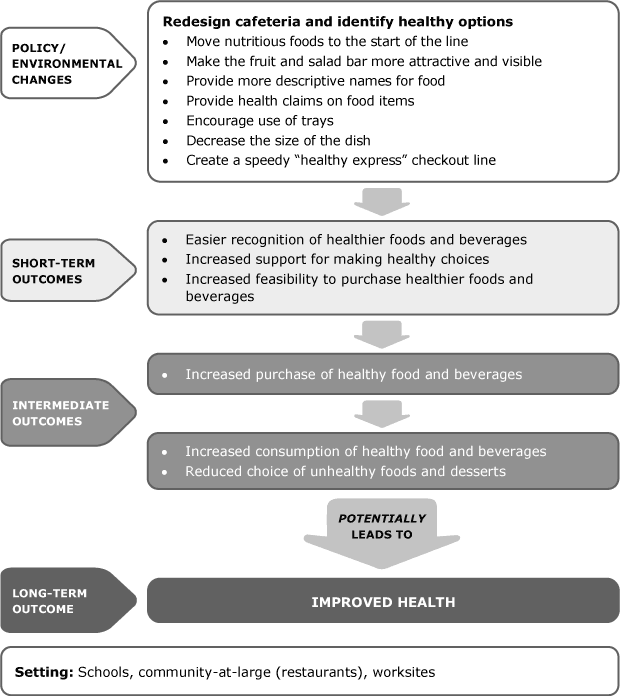Our Healthier Communities
Our Healthier Communities Initiatives are built on the concept that local communities can work together to give all community members healthy choices and support the pursuit of healthy lifestyles. More than 160 Ys are working in collaboration with community leaders to make changes in policies and the physical surroundings in those communities so that healthy living is within reach for individuals of all ages and backgrounds.
Redesign Cafeteria and Identify Healthy Options
Presenting healthier foods in attractive, informative ways that highlight their health benefits affects people's attitudes about those foods. Changing the cafeteria layout, improving the presentation of vegetables and fruits and identifying healthier items increase the consumption of healthy food and beverages.
Research has found that changing the cafeteria layout, improving the presentation of vegetables and fruits and identifying healthier items facilitate the selection of healthier items and increase consumption of healthy food and beverages, especially as part of a multicomponent intervention. For example, placing salad bars in more visible, central locations and putting fruit in a more attractive container led to increased sales. Additional research has shown that favorable nutrition information and health claims on menus result in more favorable attitudes and increased purchase intentions even when the item is not purchased.
References
- Bronx Health Reach. Bronx healthy hearts. Retrieved November 15, 2010.
- Economos, C.D., Folta, S.C., Goldberg, J., Hudson, D., Collins, J., Baker, Z., Lawson, E., & Nelson, M. (2009). A community-based restaurant initiative to increase availability of healthy menu options in Somerville, Massachusetts: Shape Up Somervile. Preventing Chronic Disease, 6(3), A102.
- Fitzpatrick, M., Chapman, G., & Barr, S. (1997). Lower-fat menu items in restaurants satisfy customers. Journal of the American Dietetic Association, 97 (5), 510–514.
- Foster, G.D., Sherman, S., Borradaile, K.E., Grundy, K.M., Vander Veur, S.S., Nachmani, J., Karpyn, A., Kumanyika, S., & Shults, J. (2008). A policy-based school intervention to prevent overweight and obesity. Pediatrics, 121(4).
- Jordan, K., Erickson, E., Cox, R., Carlson, E., Heap, E., Friedrichs, M., Moyer-Mileur, L., Shen, S., & Mihalopoulos, N. (2008). Evaluation of the Gold Medal Schools Program. Journal of the American Dietetic Association, 108 (11).
- Kozup, J., Creyer, E., & Burton, S. (2003). Making healthful food choices: The influence of health claims and nutrition information on consumers' evaluation of packaged food products and restaurant menu items. Journal of Marketing, 67(2), 19–34.
- Patterson P.M., Acharya R.N., Schmitz T.G., Foerster, S.B., Hill, E., Jones, A., & Bohm, E. (2002). Analysis of the effects of a healthy dining campaign on sales of healthy menu items. Proceedings from American Agricultural Economics Association Annual Meeting. Long Beach, CA. http://ageconsearch.umn.edu/bitstream/19892/1/sp02pa04.pdf. Retrieved November 15, 2010.
- Wansink, B., Just, D., & McKendr, J. (2010). Lunch Line Redesign. New York Times. http://www.nytimes.com/interactive/2010/10/21/opinion/20101021_Oplunch.html. Retrieved November 15, 2010.

More Healthy Living Strategies
-
Healthy Eating Strategy #2
Healthy Living Strategies -
Healthy Eating Strategy #3
Healthy Living Strategies -
Healthy Eating Strategy #4
Healthy Living Strategies